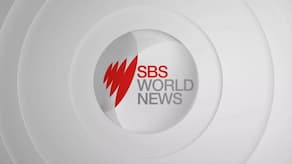Born 16 weeks premature, Kelsey Carlisle has lived with a mild intellectual disability all her life.
It's made finding long-term work difficult - and COVID-19 has only made things harder.
“It’s been very difficult,” the 24-year-old told SBS News.
“I lost my job to the pandemic last year and since then I've been having trouble. It's been a really big struggle.”
But now, the lifetime tennis fan has landed a dream role as part of an employment scheme for those who have found it tough getting a foot in the door.
She's one of 25 disadvantaged jobseekers in Victoria to secure work this year at the Australian Open through a placement program run by non-profit JobsBank, Tennis Australia and the Victorian government. Ms Carlisle said she thinks her stint at Melbourne Park will stand her in good stead for further employment going forward.
Ms Carlisle said she thinks her stint at Melbourne Park will stand her in good stead for further employment going forward.

Kelsey Carlisle (left) is one of two dozen disadvantaged jobseekers working at the 2021 Australian Open Source: Supplied
"On my resume it's going to stand out when someone sees, 'oh she has worked at the Australian Open. Let's give her an interview and let's hire her'," she said.
JobsBank chief executive Corinne Proske said the organisation works with people with disabilities, Indigenous Australians, young people, people of migrant backgrounds and the long-term unemployed.
"It's a variety of candidates, but it's really about saying diversity is actually good for our workforce. It makes sense," she said.
For French migrant Rebecca Desiree, her fortnight in hospitality at the Open will be the first time the mother-of-two has had paid work since arriving in Australia 20 months ago.
"I'm very excited. Very excited," she said.
"My husband even took two weeks off just to make sure everything will be okay."
Lauren Quittner has also seized on the chance to work at the Open. She recently finished a diploma in travel and tourism - one of the industries hardest-hit by coronavirus.
"It's an amazing opportunity to be at such a big worldwide event and getting to be a part of the atmosphere,” she said.
Program participants are given preparation before their assignments and then followed up with afterward, Victorian Employment Minister Jaala Pulford said.
"[That's] so that we make sure that we are setting them up in the workforce and have successful working lives, but also so that Tennis Australia can provide us with feedback about how we can build on this program," she said.
"Even with the challenges that have been here this year, we are all pretty ambitious about what we are able to do in future years in terms of really scaling this up."
Australian Open organisers said the placement program was an opportunity to promote inclusion and diversity in tennis.
"This is another piece where we are focusing on inclusion at all levels of the game: with our fans, with accessibility, with our players, with our participants and also our workforce," Tennis Australia community relations executive Vicki Reid said.
Attendance at this year’s Australian Open, which began on Monday, has been below average due to the coronavirus.
Only 30,000 people per day are being allowed into Melbourne Park, which is less than 50 per cent capacity.
The tournament has also been pushed back three weeks this year - no longer falling in school holidays - and restricted travel to Australia has kept international fans from attending.
With AAP.



